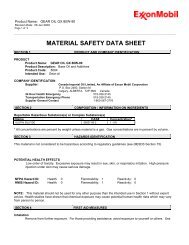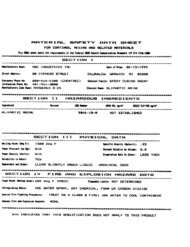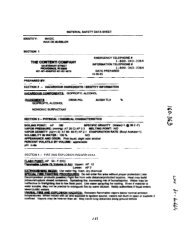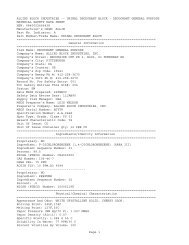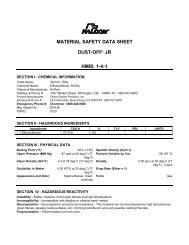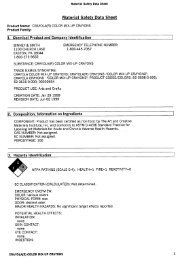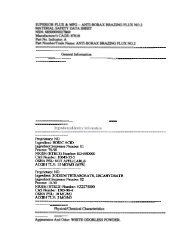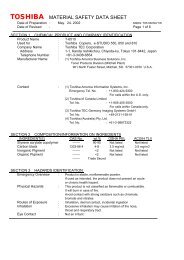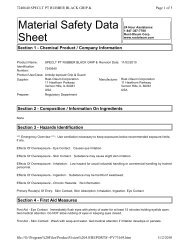Material Safety Data Sheet
Material Safety Data Sheet
Material Safety Data Sheet
You also want an ePaper? Increase the reach of your titles
YUMPU automatically turns print PDFs into web optimized ePapers that Google loves.
<strong>Material</strong> <strong>Safety</strong> <strong>Data</strong> <strong>Sheet</strong><br />
1. Chemical Product and Company Identification<br />
Common Name<br />
Synonym<br />
Catalogue number<br />
Supplier<br />
NEWS 610 Activator<br />
KAN 442195; PCD 5330; A-0019.501<br />
143 6401; 790 0018<br />
Area of Application : Industrial applications. Graphic Arts Imaging.<br />
Emergency telephone<br />
number<br />
For other EHS<br />
Information<br />
:<br />
:<br />
:<br />
:<br />
:<br />
:<br />
NEWS 610 Activator<br />
Anitec Newspaper Company<br />
383 Dwight Street<br />
Holyoke, MA 01040<br />
USA<br />
Tel. (413) 538-9624<br />
In Case of Emergency (medical/roadside) (24hrs)<br />
Kodak Polychrome Graphics, Environmental Solutions Department;<br />
11465 Johns Creek Parkway, #260, Duluth, GA 30097; USA<br />
Phone: 1-877-574-7274 ext. 511, Additional phone: (770) 232-2133<br />
E-mail: PEP@kpgraphics.com, Fax: (770) 232-2150;<br />
2. Composition, Information on Ingredients<br />
1) Water 7732-18-5 85-90 Not available.<br />
2) Sodium sulfite 7757-83-7 5-10 Not available.<br />
3) Sodium thiosulfate 7772-98-7 1-5 Not available.<br />
4) 2-(Methylamino)ethanol 109-83-1 1-5 Not available.<br />
5) Glycerol 56-81-5 1-5 TWA: 10 (mg/m 3 )<br />
6) Hydroquinone 123-31-9
NEWS 610 Activator<br />
Medical Conditions<br />
Aggravated by<br />
Overexposure:<br />
Overexposure<br />
/Signs/Symptoms<br />
See Toxicological Information (section 11)<br />
4. First Aid Measures<br />
Eye Contact<br />
Skin Contact<br />
Inhalation<br />
Ingestion<br />
5. Fire Fighting Measures<br />
Flammability of the<br />
Product<br />
Auto-Ignition<br />
Temperature<br />
Hazardous thermal<br />
(de)composition<br />
products<br />
Fire Hazards in<br />
Presence of Various<br />
Substances<br />
Explosion Hazards in<br />
Presence of Various<br />
Substances<br />
Fire Fighting Media<br />
and Instructions<br />
Protective Clothing<br />
(Fire)<br />
Special Remarks on<br />
Fire Hazards<br />
Special Remarks on<br />
Explosion Hazards<br />
:<br />
:<br />
:<br />
:<br />
:<br />
:<br />
:<br />
:<br />
:<br />
:<br />
:<br />
:<br />
:<br />
:<br />
:<br />
Page: 2/6<br />
Repeated or prolonged exposure is not known to aggravate medical condition. Although responses have<br />
not been consistent across routes of exposure, species, or sex, some animal studies suggest that<br />
hydroquinone is weakly tumorigenic for rodents following the administration of high oral doses. In contrast,<br />
long-term epidemiological studies of employees engaged in the manufacturing and use of hydroquinone<br />
have shown no evidence of increased cancer risk from exposure to hydroquinone.<br />
-<br />
Check for and remove any contact lenses. In case of contact with eyes, rinse immediately with plenty of<br />
water. Seek medical attention.<br />
After contact with skin, wash immediately with plenty of water. If irritation persists, seek medical attention.<br />
Allow the victim to rest in a well-ventilated area. If irritation persists, seek medical attention.<br />
INDUCE VOMITING by sticking finger in throat. Have conscious person drink several glasses of water or<br />
milk. Seek medical attention.<br />
Non-flammable.<br />
Not applicable.<br />
sulfur oxides (SO2, SO3...) carbon oxides (CO, CO2)<br />
Not applicable.<br />
-<br />
Use DRY chemicals, CO2, water spray or foam.<br />
Be sure to use an approved/certified respirator or equivalent.<br />
-<br />
None.<br />
6. Accidental Release Measures<br />
Small Spill and Leak<br />
Large Spill and Leak :<br />
7. Handling and Storage<br />
Handling<br />
Storage<br />
Continued on Next Page<br />
:<br />
:<br />
:<br />
Dilute with water and mop up, or absorb with an inert dry material and place in an appropriate waste<br />
disposal container. If necessary: Neutralize the residue with a dilute solution of acetic acid. Finish<br />
cleaning by spreading water on the contaminated surface and dispose of according to local and regional<br />
authority requirements.<br />
Absorb with an inert material and put the spilled material in an appropriate waste disposal. Neutralize<br />
the residue with a dilute solution of acetic acid. Finish cleaning by spreading water on the contaminated<br />
surface and dispose of according to local and regional authority requirements.<br />
Avoid breathing vapors or spray mists. Avoid contact with skin and clothing. Do not get in eyes. Keep<br />
container closed. Use only with adequate ventilation. Wash thoroughly after handling.<br />
Store at room temperature 25°C (77°F) or lower. Prevent from freezing
NEWS 610 Activator<br />
8. Exposure Controls, Personal Protection<br />
Engineering Controls<br />
Personal Protection<br />
Eyes<br />
Body<br />
Respiratory<br />
Protective Clothing<br />
(Pictograms)<br />
Hands<br />
Feet<br />
Personal Protection in<br />
Case of a Large Spill<br />
1) Water<br />
2) Sodium sulfite<br />
3) Sodium thiosulfate<br />
4) 2-(Methylamino)ethanol<br />
5) Glycerol<br />
6) Hydroquinone<br />
:<br />
:<br />
:<br />
:<br />
:<br />
:<br />
:<br />
:<br />
Page: 3/6<br />
Use good general ventilation(>10 air changes/hour) and engineering controls (local exhaust, filter's,<br />
process enclosures if necessary) to maintain airborne levels below ACGIH Threshold Limit Values (TLV)<br />
and OSHA Permissible Exposure Limits(PEL). Ensure that eyewash station and safety shower is proximal<br />
to the work-station location.<br />
Splash goggles.<br />
Lab coat.<br />
Wear appropriate respirator when ventilation is inadequate.<br />
Gloves (impervious).<br />
Not applicable.<br />
Splash goggles. Lab coat. Gloves (impervious). Ventilation is normally required when handling or using<br />
this product (typically 10 air changes per hour).<br />
Product Name Exposure Limits<br />
Consult local authorities for acceptable exposure limits.<br />
9. Physical and Chemical Properties<br />
Physical State and<br />
Appearance<br />
Molecular Weight<br />
Molecular Formula<br />
pH (1% Soln/Water)<br />
Boiling/Condensation<br />
Point<br />
Melting/Freezing Point<br />
Density<br />
Specific Gravity<br />
Vapor Pressure<br />
Vapor Density<br />
Volatility<br />
VOC by EPA Method<br />
24<br />
VOC Calculated<br />
Ionicity (in Water)<br />
Dispersion Properties<br />
Solubility<br />
Liquid.<br />
Not applicable.<br />
11 [Basic.]<br />
>100°C (212°F)<br />
NEWS 610 Activator<br />
10. Stability and Reactivity<br />
Stability and Reactivity<br />
Conditions of Instability<br />
Incompatibility with<br />
Various Substances<br />
Hazardous<br />
Decomposition Products<br />
Hazardous<br />
Polymerization<br />
The product is stable.<br />
-<br />
Incompatible with some strong acids.<br />
sulfur oxides (SO2, SO3...) carbon oxides (CO, CO2)<br />
Will not occur.<br />
11. Toxicological Information<br />
Toxicity to Animals<br />
Chronic Effects on<br />
Humans<br />
Other Toxic Effects on<br />
Humans<br />
12. Ecological Information<br />
Biodegradable/OECD<br />
BOD5 and COD<br />
Ecotoxicity<br />
Toxicity of the Products<br />
of Biodegradation<br />
:<br />
:<br />
:<br />
:<br />
:<br />
:<br />
:<br />
:<br />
Water:<br />
ORAL (LD50): Acute: >90000 mg/kg [Rat].<br />
Sodium sulfite:<br />
ORAL (LD50): Acute: 6400 mg/kg [Rat].<br />
Sodium thiosulfate:<br />
ORAL (LD50): Acute: >5000 mg/kg [Rat].<br />
2-(Methylamino)ethanol:<br />
ORAL (LD50): Acute: 2340 mg/kg [Rat].<br />
Glycerol:<br />
ORAL (LD50): Acute: 12600 mg/kg [Rat].<br />
Hydroquinone:<br />
ORAL (LD50): Acute: 320 mg/kg [Rat].<br />
DERMAL (LD50): Acute: 900 mg/kg [Rat, Rabbit].<br />
Page: 4/6<br />
CARCINOGENIC EFFECTS: Classified None. by OSHA [Sodium sulfite]. Classified None. by OSHA<br />
[Sodium thiosulfate]. Classified None. by OSHA [2-(Methylamino)ethanol]. Classified A3 (Proven for<br />
animal.) by ACGIH [Hydroquinone]. Classified None. by OSHA [Hydroquinone]. Classified 3 (Not<br />
classifiable for human.) by IARC [Hydroquinone].<br />
Hazardous in case of skin contact (irritant), of eye contact (corrosive). Although responses have not been<br />
consistent across routes of exposure, species, or sex, some animal studies suggest that hydroquinone is<br />
weakly tumorigenic for rodents following the administration of high oral doses. In contrast, long-term<br />
epidemiological studies of employees engaged in the manufacturing and use of hydroquinone have<br />
shown no evidence of increased cancer risk from exposure to hydroquinone.<br />
Not available.<br />
13. Disposal Considerations<br />
Waste Information<br />
Consult your local or regional authorities.<br />
14. Transport Information<br />
DOT Classification :<br />
Continued on Next Page<br />
:<br />
:<br />
:<br />
:<br />
:<br />
-<br />
Ecotoxicity in water (LC50): 2600 mg/l 96 hours [Fish]. 69 mg/l 48 hours [Daphnia]. (Sodium sulfite). 100<br />
mg/l 96 hours [Fish]. (2-(Methylamino)ethanol).<br />
The product itself and its products of degradation are not toxic.<br />
Waste must be disposed of in accordance with federal, state and local environmental control regulations.<br />
Not a DOT controlled material (United States).<br />
Not applicable.<br />
Not applicable.
NEWS 610 Activator<br />
Marine Pollutant : -<br />
Hazardous Substances<br />
Reportable Quantity<br />
Special Provisions for<br />
Transport<br />
TDG Classification<br />
ADR/RID Classification<br />
IMO/IMDG<br />
Classification<br />
ICAO/IATA<br />
Classification<br />
HCS Classification<br />
U.S. Federal Regulations<br />
:<br />
:<br />
:<br />
:<br />
:<br />
:<br />
Not applicable.<br />
-<br />
Not applicable.<br />
Not controlled under TDG (Canada).<br />
Not controlled under ADR (Europe).<br />
Not controlled under IMDG.<br />
Not applicable.<br />
Not applicable.<br />
Not applicable.<br />
Not controlled under IATA.<br />
Not applicable.<br />
Not applicable.<br />
15. Regulatory Information<br />
International<br />
Regulations<br />
WHMIS<br />
(Canada)<br />
DSCL (EEC)<br />
International<br />
Lists<br />
State Regulations<br />
Continued on Next Page<br />
:<br />
:<br />
:<br />
:<br />
:<br />
CLASS: Irritating substance.<br />
Clean Water Act (CWA) 311: No products were found.<br />
Clean air act (CAA) 112 accidental release prevention: No products were found.<br />
Clean air act (CAA) 112 regulated flammable substances: No products were found.<br />
Clean air act (CAA) 112 regulated toxic substances: No products were found.<br />
CLASS D-2B: <strong>Material</strong> causing other toxic effects (TOXIC).<br />
No products were found.<br />
R36/38- Irritating to eyes and skin.<br />
-<br />
No products were found.<br />
California prop. 65: No products were found.<br />
Page: 5/6<br />
: TSCA 8(b) inventory: Water<br />
SARA 302/304/311/312 extremely hazardous substances: No products were found.<br />
SARA 302/304 emergency planning and notification: Hydroquinone<br />
SARA 302/304/311/312 hazardous chemicals: No products were found.<br />
SARA 311/312 MSDS distribution - chemical inventory - hazard identification: Sodium sulfite: immediate<br />
health hazard, delayed health hazard; 2-(Methylamino)ethanol: fire, immediate health hazard;<br />
Hydroquinone: immediate health hazard, delayed health hazard<br />
SARA 313 toxic chemical notification and release reporting: Hydroquinone 0.9%<br />
Clean Water Act (CWA) 307: No products were found.<br />
This product has been classified in accordance with hazard criteria of the Controlled Products Regulations<br />
and the MSDS contains all the information required by the Controlled Products Regulations.
NEWS 610 Activator<br />
16. Other Information<br />
Label Requirements<br />
Hazardous <strong>Material</strong><br />
Information System<br />
(U.S.A.)<br />
References<br />
Other Special<br />
Considerations<br />
:<br />
:<br />
:<br />
:<br />
Health<br />
Fire Hazard<br />
Reactivity<br />
Personal Protection<br />
Not available.<br />
Not available.<br />
* 2 National Fire<br />
0<br />
0<br />
Protection<br />
Association (U.S.A.) Health<br />
Validated by Kodak Polychrome Graphics on 2000-09-06. Verified by Kodak Polychrome Graphics.<br />
In Case of Emergency CALL 1-800-451-8346<br />
B<br />
Printed 2000-09-06.<br />
Page: 6/6<br />
CAUSES SEVERE SKIN IRRITATION. CAUSES EYE IRRITATION. MAY CAUSE ALLERGIC SKIN<br />
REACTION. MAY BE HARMFUL IF SWALLOWED. POSSIBLE CANCER HAZARD. CONTAINS<br />
MATERIAL WHICH MAY CAUSE CANCER BASED ON ANIMAL DATA.<br />
Notice to Reader<br />
To the best of our knowledge, the information contained herein is accurate. However, neither the above named supplier nor any of its<br />
subsidiaries assumes any liability whatsoever for the accuracy or completeness of the information contained herein.<br />
Final determination of suitability of any material is the sole responsibility of the user. All materials may present unknown hazards and should be<br />
used with caution. Although certain hazards are described herein, we cannot guarantee that these are the only hazards that exist.<br />
1<br />
0<br />
0<br />
Fire Hazard<br />
Reactivity<br />
Specific Hazard




